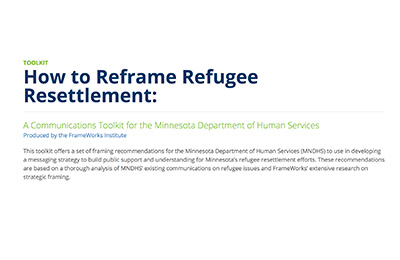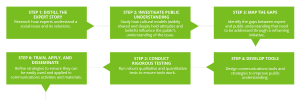
Introduction
This toolkit offers a set of framing recommendations for the Minnesota Department of Human Services (MNDHS) to use in developing a messaging strategy to build public support and understanding for Minnesota’s refugee resettlement efforts. These recommendations are based on a thorough analysis of MNDHS’ existing communications on refugee issues and FrameWorks’ extensive research on strategic framing.
Strategic Frame Analysis™
To build the capacity of the public sector to communicate more effectively about social issues, FrameWorks has developed Strategic Frame Analysis® (SFA), a multidisciplinary, multi-method approach to message development that tests the effects of issue frames on public understanding and engagement. This process aims to find the most effective strategies for inviting the public into conversations about pressing policy topics so that community decision-making can be more informed by research and evidence. FrameWorks’ methodology is as follows:
Framing Recommendations
An effective social change narrative doesn’t select the beginning, middle, and end on a whim, or merely for a pleasing literary effect. Rather, it fills in the chapters strategically, anticipating where and why the story will be difficult to tell. By filling in these blanks consistently, systematically, and scientifically—choosing among plausible alternatives by looking to evidence about the effects of frames—and using narrative consistently to shape a variety of communications efforts, MNDHS can significantly advance public understanding of refugee issues.
Recommendation #1: Order matters. Harness the power of story-telling.
Harness the Power of Storytelling
People think in narrative; we use storytelling all the time to make sense of the world around us. Strategic framing harnesses this cognitive feature by organizing information about an issue into story form, which aids people’s interpretation of a message. MNDHS communicators have the difficult task of building public understanding of two complex systems:
- How the US immigration system works with respect to refugee-related issues.
- The kinds of human and social services that are (or should be) available to refugees to assist the resettlement process.
We recommend a narrative that organizes information in a way that fits people’s expectations about what a good story sounds like.
Lead with Values
Values provide a goal for people to think collectively about what they want from society. Therefore, they work well at the beginning of a communication to establish why an issue matters. Choosing the right value, however, is an empirical pursuit. FrameWorks research has identified two specific values that can help orient messages on refugee resettlement: Human Dignity and Collective Prosperity.

Use Explanatory Metaphors
Explanatory metaphors help people evaluate whether the system is working to achieve positive outcomes or not. They help explain the mechanisms of the problem to help people engage in the systems-oriented thinking needed to address large-scale social change. FrameWorks research has identified two metaphors that help explain the dynamics of refugee resettlement: Sail and Building Wellbeing

Provide Solutions
The narrative is incomplete without the final chapter: a discussion of which solutions Minnesotans should support to improve the state’s refugee resettlement system. When people understand a problem’s causes and effects, they are better able to think productively about needed solutions. Communicators should leverage this and consider including solutions in all materials where possible.

Recommendation #2: Start with why refugee resettlement matters.
Use Tested Values to Establish What Is at Stake
Before the public will throw its support behind a policy issue, it first needs to understand why that issue matters. On issues related to community and social wellbeing, we have found that values emphasizing shared benefits and the common good are best able to boost public support for expert-recommended solutions. The values Shared Prosperity and Human Dignity have been shown across issue areas to help the public think about the collective benefits of more expansive and welcoming immigration (including refugee) policies. The good news is that MNDHS is already using these values in its communications. Below are two examples of how communicators can enhance their use of these values.
The Resettlement Programs Office works with many others to support the effective resettlement of refugees in Minnesota by helping meet their basic needs so that they can live in dignity and achieve their highest potential.
We need the skills and energy of every Minnesotan so our state can thrive. The Resettlement Programs Office works with many others to make sure that refugees who come to our state can achieve their highest potential and strengthen our state.
Refugees are people who have fled their home country and cannot return because of a well-founded fear of persecution based on religion, race, nationality, political opinion, or membership in a particular social group, and whose home government is either unwilling or unable to protect them.
Governments should respect and protect the dignity and humanity of all people, regardless of race, nationality, religion, political opinions, or membership in particular social groups. Refugees are people who have fled their home country and cannot return because of a well-founded fear of persecution based on their identity or beliefs, and whose home government is either unwilling or unable to protect them. Refugee policy in Minnesota reflects our ideals of compassion and dignity for all by maintaining a humane resettlement system for those who are unsafe in their home countries.
Recommendation #3: Explain how the refugee system works.
Use the Sail Metaphor to Explain How the System Works.
The Sail helps communicators explain how the immigration system works for refugees, encourages members of the public to think more expansively about refugees’ potential contributions, and channels thinking toward the ways in which more welcoming refugee policies benefit all Minnesotans. The following iteration shows how communicators might use the metaphor in the beginning of a speech, a commentary, or another communications opportunity.
Throughout Minnesota’s history, refugees and other newcomers have been the wind in our state’s sails.
Most refugees become citizens and make our “land of lakes” their permanent home. They bring labor, skills, and ideas that propel our state forward.
Right now, the Minnesota system’s “sails” are positioned well—we are able to incorporate and make full use of the energy that refugees bring. It’s important that we keep the sails working well and reject any proposed policies that may lower them and slow our progress. With our immigration sails unfurled, we can keep families intact and realize the full potential that refugees contribute to our communities. Maintaining humane refugee policies helps our state move forward faster.
Recommendation #4: Increase support for programs.
Use the Building Wellbeing Metaphor to Build Support for Human Services.
The Building Wellbeing metaphor boosts public support for policies, programs, and funding related to human services. MNDHS can extend this metaphor to communicate about how human services work together to support wellbeing for refugees. The Building Wellbeing metaphor moves people beyond their dominant perceptions that aid agencies provide (and should only provide) temporary supports that address basic needs. This limited understanding obscures the purpose and results of these agencies’ efforts to create a foundation for community- and population-level success. The following iteration shows how communicators might use the metaphor in the beginning of a series of talking points.
Just as building a strong house requires certain materials, building wellbeing requires community resources, social relationships, and opportunities to thrive. These materials are often not available to people fleeing dangerous and violent situations. Without these supports, refugees sometimes struggle to participate fully in our communities. But when we invest in building everyone’s wellbeing, we ensure that everyone is able to weather even the most severe of life’s storms.
Makes clear that wellbeing, like a house, is constructed through the collaborative effort of many stakeholders. This helps to expand the public’s attribution of responsibility for solving social problems.
Just as building a strong house requires certain materials, building wellbeing requires community resources, social relationships, and opportunities to thrive. These materials are often not available to people fleeing dangerous and violent situations. Without these supports, refugees sometimes struggle to participate fully in our communities. But when we invest in building everyone’s wellbeing, we ensure that everyone is able to weather even the most severe of life’s storms.
Steers people away from individual-focused solutions; after all, houses don’t build themselves.
Just as building a strong house requires certain materials, building wellbeing requires community resources, social relationships, and opportunities to thrive. These materials are often not available to people fleeing dangerous and violent situations. Without these supports, refugees sometimes struggle to participate fully in our communities. But when we invest in building everyone’s wellbeing, we ensure that everyone is able to weather even the most severe of life’s storms.
Illustrates how investing in sturdy wellbeing can prevent or mitigate future problems.
Recommendation #5: Complete the story by pointing to solutions.
The 5 “C’s” of Conclusion
Every story needs a good ending, and a strategically framed story is no exception. The ultimate goal of using tested values and metaphors in your communications is to point people towards solutions—towards the policies, programs, and principles that are necessary to address the problem, ensure good outcomes, or improve conditions. By establishing what’s at stake in an issue and how it works, these other frame elements set the stage for a strong conclusion, allowing communicators to complete the narrative with explanations of what concrete steps, calls to action, or expressions of support experts understand are needed to make sure the issue is addressed effectively. For example, a story about workforce development for recently arrived refugees may show how funding language classes helps refugees move into the workforce more quickly and recommend that existing funding be sustained or expanded.
Without solutions—the satisfying ending to a well-framed narrative—the public is left wondering what it should do. Don’t leave your audience hanging!
FrameWorks has developed a five-point checklist that communicators can use to “frame-check” their messages’ conclusions:
Are the solutions specific? Have you offered details about how they work?
Does your ending make it clear that the problem and its solution exists at a systemic level and requires public attention and support?
Are the solutions discussed linked explicitly in the message to the problems they are designed to solve? Is the chain of cause and effect clear enough for non-experts to understand?
Are the solutions feasible? Do they encourage a sense of efficacy?
Are the solutions presented in a disinterested way that steers clear of cues that might trigger partisan feelings or debate?
Traps in Communications
Communications Strategies to Avoid
Some ways of framing an issue ensnare public thinking in unproductive evaluations and judgments, or traps. These traps are plausible ways of framing an issue and respond logically to challenges that communicators have observed from experience. However, framing research shows that they fail to achieve their desired effect—and sometimes, they turn out to do more harm than good. FrameWorks research on how the public thinks about immigration and human services suggests that communicators need to be wary of the following traps as they engage the public:
Click the communications traps.
THE WORTHINESS TRAP
Communicators want to convince the public that refugees are “worthy and deserving recipients of public assistance.” In existing communications, MNDHS establishes worthiness in two ways:
- Showing how refugees have better outcomes than non-immigrant groups that receive public assistance.
- Emphasizing refugees’ legal (as opposed to illegal) status.
Why this strategy can backfire:
- Direct comparisons with US-born groups may inadvertently activate Zero-Sum thinking, where supporting one community necessarily means taking supports away from others. The public tends to be less supportive of a robust system of human services when thinking in these terms.
- Even implicit differentiation of refugees from other kinds of immigrants may be counterproductive to the larger immigration reform movement, particularly for advocates who are working to improve conditions for those without legal status.
Suggestion:
Rather than focusing on the worthiness of individual people or groups of refugees, the strategies suggested here channel attention to improving the systems that support refugee resettlement.
THE DEMOGRAPHIC CHANGE TRAP
Analysis of MNDHS’ public engagement materials reveal that the field tends to argue for reforms to the refugee system by pointing to future demographic change, particularly the “graying” of Minnesota’s population.
Why this strategy can backfire:
- This line of argument is based on an impending demographic crisis. Extensive research in the social sciences shows that fear-based messages may garner short-term attention but discourage public engagement over more extended periods of time. 1
- This line of argument may inadvertently trigger an Us vs. Them perspective, which will likely dampen support for refugee resettlement programs.
Suggestion:
Use values rather than data to open the case for why refugee issues are a matter of public concern and clearly communicate the benefits of a strong refugee resettlement program for all Minnesotans.
1. See for example, Witte, K. & Allen, M. ‘A meta-analysis of fear appeals: Implications for effective public health campaigns.’ Health Education & Behavior 27, no. 5 (2000): 591-615.
MYTH/FACT TRAP
Myth/fact sheets are pervasive in communications materials across issue areas, but social science research has demonstrated repeatedly that they are counterproductive. While myth/fact sheets might seem like a good strategy for correcting misconceptions, they are likely to backfire.
Why this strategy can backfire:
Due to the way people process and recall information, repeating a misconception before introducing a correction reinforces the misconception—not the correction. Studies have shown that myth/fact sheets can lead to a decline in understanding and regressions in policy support.
Suggestion:
Avoid headlines and myth/fact-type statements that use the same language as the idea you’re trying to refute. Instead, use systems and solutions-based statements when presenting facts.
THE JUST THE FACTS TRAP
The use of numbers and statistics can be an effective communications strategy, but only if they are properly framed.
Why this strategy can backfire:
While the meaning of a given data point or statistic may be obvious to experts and advocates, the public often interprets numbers in unexpected and potentially unproductive ways, especially when they are not supported by contextual information.
Suggestion:
Stay away from “naked” numbers; place statistics within a frame that aids interpretation and guides meaning-making.
THE STATE BY STATE COMPETITION TRAP
Communicators are often tempted to raise the salience of an issue by highlighting how poorly it is being addressed in comparison to other states. The idea is that when people are informed of how their state ranks against other states, they will be motivated to take action to address the issue.
Why this strategy can backfire:
- Rather than inspire people to take action, state-by-state comparisons can actually increase fatalism about the possibility of change. The thinking goes, “Why should I do anything if our state is 47th out of 50 states?”
- It frames social issues as competitive rather than cooperative endeavors and therefore can inadvertently cue Us vs. Them thinking.
Suggestion:
Refrain from using direct comparisons to other programs/states in a competitive manner. Instead, highlight successful policies/programs that your program can emulate.
Framing Resources
Strategically Framed Tools and Resources
Now that you understand the importance of strategic framing, the common communications traps to avoid, and the five recommendations on how to communicate about refugee resettlement, you are equipped to deploy your message to the field. Download and use the resources and tools below to help build your coalition and engage your audience(s) in more productive ways.
Related Research
Research Base
FrameWorks specializes in rigorous communications research on a wide range of social issues. The strategies and recommendations found in this toolkit draw from our robust work on human services and immigration. We’ve provided this extensive body of work here for further reading.
Talking Human Services: A FrameWorks MessageMemo
Handed to Them on a Plate: Mapping the Gaps Between Expert and Public Understandings of Human Services
Finish the Story on Immigration
Getting to “We”: Mapping the Gaps Between Expert and Public Understandings of Immigration and Immigration Reform
Stories Matter: Field Frame Analysis on Immigration Reform
Valuing Immigration: How Frame Elements Contribute to Effective Communications
TERMS AND ACKNOWLEDGEMENT
All materials and recommendations found in this toolkit were designed and developed by the FrameWorks Institute for the Minnesota Department of Human Services, Refugee Resettlement Program (2017). Advocates and communicators are encouraged to use this toolkit’s framing recommendations and resources (values, metaphors, narratives, etc.) in internal and public-facing communications dealing with refugee resettlement programs. For other uses—such as training and strategic consulting—please see FrameWorks’ terms of use to seek appropriate permissions.





